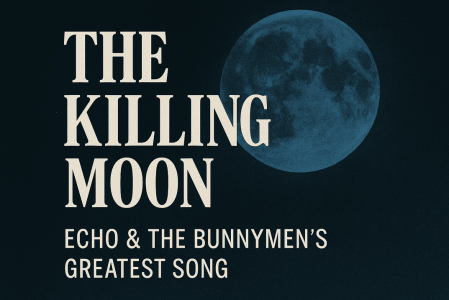The Killing Moon is more than just a song—it’s a defining moment in Echo & the Bunnymen’s career and a standout track in 1980s music. With its haunting sound and poetic lyrics, it has earned a place among the most iconic singles of its era.
Context & Creation
By the early 1980s, Echo & the Bunnymen had carved out a key spot in the UK’s post-punk landscape. Known for their moody sound and poetic lyrics, they stood apart from their peers with a more atmospheric approach. Albums like Crocodiles and Heaven Up Here earned them critical respect, but it was 1984’s Ocean Rain—and its lead single, The Killing Moon—that took them to a new level.
The song’s origins are rooted in a dream. Ian McCulloch claimed he woke up with the line “fate up against your will” in his head. That phrase became the song’s emotional anchor. Guitarist Will Sergeant contributed a dark, surf-influenced riff, while the band built the rest around its slow, hypnotic groove. They recorded the song at Crescent Studios in Bath, with strings added later in Paris to give it a lush, cinematic feel.
The result was unlike anything else in post-punk at the time. With its deep basslines, sweeping strings, and echoing guitar lines, The Killing Moon created a dreamlike space—both intimate and grand.
Lyrics & Meaning
At its core, The Killing Moon is about fate—inescapable, dark, and strangely romantic. The lyrics speak to a love marked by inevitability: “Fate up against your will” becomes a chilling refrain that captures the song’s fatalistic mood. Themes of death, desire, and surrender run throughout, giving it a gothic, almost spiritual tone.
Ian McCulloch has described the song as the greatest ever written, believing the lyrics were “given” to him in a moment of inspiration. He’s called it a song about destiny and accepting the power of forces beyond human control. In his view, it’s not just about death, but the beauty in surrendering to something larger than yourself.
Listeners and critics have often seen religious and literary undertones. The moon, long a symbol of mystery and change, becomes a silent witness to emotional collapse. There are echoes of romantic poets in the phrasing and symbolism—Keats, perhaps, in its melancholic beauty. The song’s layered imagery invites interpretation, which has helped it stay relevant and resonant over the decades.
Musical Composition
The Killing Moon is built on a slow, deliberate structure that mirrors its lyrical weight. The song opens with a rich, arpeggiated guitar line that sets the mood—dark, spacious, and hypnotic. From there, the arrangement unfolds gradually, with a steady rhythm section, lush string parts, and subtle keyboard textures filling in the atmosphere.
The song is in a minor key, which gives it its haunting, melancholic tone. The chord progression—rooted in G minor—avoids resolution, creating a sense of unease that fits the themes of fate and surrender. Will Sergeant’s guitar work is central, using reverb and delay to give each note a ghostly presence. The strings, recorded separately in Paris, add a cinematic layer that elevates the track beyond typical post-punk.
Musically, the band drew from a wide range of influences. There’s a clear nod to The Doors in the song’s mood and pacing—Jim Morrison’s shadow looms in McCulloch’s delivery. David Bowie’s Space Oddity and Scott Walker’s orchestral ballads also echo in the song’s blend of pop structure and artful ambition. Still, The Killing Moon remains its own creation—moody, immersive, and unmistakably Echo & the Bunnymen.
Cultural Footprint
The Killing Moon has lived far beyond its original release, finding new audiences through film, television, and reinterpretations. Most notably, it plays a central role in the opening of Donnie Darko (2001), setting the tone for the film’s eerie, time-warped world. Director Richard Kelly has said he couldn’t imagine the movie without it. The song also featured in a high-profile Gears of War commercial, introducing its brooding beauty to a new generation through gaming culture.
The track has been covered by artists across genres, including Pavement, Nouvelle Vague, and even pop singer Greg Laswell. Each version highlights its flexibility—how its core mood can shift from dreamy to devastating, depending on the performer. These covers are a testament to the song’s strong bones and timeless quality.
For Echo & the Bunnymen, The Killing Moon became their signature. While they have a deep and respected catalog, no other song captures their essence quite like this one. It defines their sound—romantic, shadowy, and grand—and has become a cornerstone of their live shows and public memory. In many ways, it is the song that secured their place in music history.
Closing Thoughts
Decades after its release, The Killing Moon still holds a powerful grip on listeners. Its haunting melody, poetic lyrics, and rich atmosphere give it a timeless quality that few songs achieve. It captures a feeling—of love, fate, and quiet doom—that speaks across generations.
For Echo & the Bunnymen, it stands as their definitive work. No other track so perfectly distills their sound and vision. The Killing Moon is not just a high point in their career; it’s a landmark in post-punk and a lasting piece of pop history.
